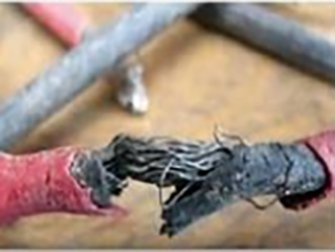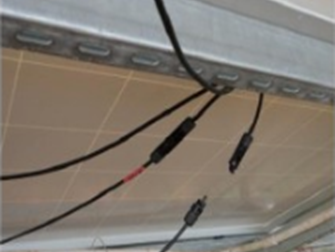As an important component of the entire power station, the solar inverter is used to detect DC components and grid-connected equipment. Basically, all power station parameters can be detected by the solar inverter. If an abnormality occurs, the health of the power station's supporting equipment can be checked through the information fed back by the solar inverter. The following is a summary of some common fault information and treatment methods for photovoltaic solar inverters.

No mains connection
cause of issue:
It means that the AC power is not connected or the AC circuit breaker is disconnected, causing the solar inverter to be unable to detect the AC power voltage.
Solution:
1. Determine whether the power grid is out of power. If so, wait for the power grid to resume power supply.
2. If the power supply from the power grid is normal, use the AC voltage range of a multimeter to measure whether the AC output voltage is normal. First, measure the solar inverter output port and check whether there is any problem on the output side of the solar inverter. If there is no problem, it means there is a circuit break on the external AC side. You need to check whether the air switch, knife switch, over-voltage and under-voltage protector and other safety switches are damaged or open circuit.
AC voltage out of range
cause of issue:
When photovoltaic power generation is connected to the user-side power grid, the voltage of the access point will increase. The greater the internal resistance of the power grid, the greater this appreciation. The closer to the transformer, the smaller the line resistance, the smaller the fluctuations in the grid will be, and the closer to the end of the grid, the longer the lines, the greater the voltage fluctuations. Therefore, when the solar inverter is connected to the grid far away from the transformer, the grid working environment of the solar inverter will become very poor. After the upper limit of the solar inverter's operating voltage is exceeded, the solar inverter will report a fault and stop working. According to the technical specifications for photovoltaic power generation grid-connected solar inverters (NB/T 32004-2018), the requirements for overvoltage/undervoltage protection on the AC output side: When the voltage at the AC output terminal of the solar inverter exceeds the allowable voltage range of the grid, the solar inverter is allowed to shut down. Turn on the power supply to the power grid and send out a warning signal when it is cut off. The solar inverter should be able to start and operate normally when the grid voltage returns to the allowable voltage range.
Solution:
1. Try to place the access point of the photovoltaic power station as close to the output end of the transformer to reduce line losses.
2. Try to shorten the line length of the solar inverter AC output end, or use thicker copper core cables to reduce the voltage difference between the solar inverter and the grid.
3. Now most grid-connected solar inverters have AC voltage regulation function. You can contact the manufacturer to widen the AC voltage range to adapt to grid voltage fluctuations.
4. If possible, the output voltage of the transformer can be appropriately lowered.
Low insulation resistance
cause of issue:
The solar inverter has the function of detecting the insulation impedance of the DC side. When it detects that the DC positive and negative impedance to the ground is lower than 50kΩ, the solar inverter will report "PV insulation impedance is too low fault" to prevent the human body from touching the live part of the panel and the ground at the same time, causing the risk of electric shock. Influencing factors include: DC component leakage; cable insulation damage, live exposed part moisture; component bracket grounding is poor; weather and power station environment humidity is too high, etc.


Solution:
Disconnect the AC and DC circuit breakers, use the special MC4 disassembly wrench to remove the positive and negative poles of the DC test string to ensure that the component bracket is reliably grounded, use the multimeter megohm range, connect the red test lead to the positive pole of the string, and the black test lead to the ground, read the impedance reading of each positive pole to the ground, and then connect the red test lead to the negative pole of the string, and then read the impedance reading of each negative pole to the ground. If it is greater than 50kΩ, it is judged that the string insulation is reliable. If it is less than or equal to 50kΩ, it is judged that there is a problem with the string insulation. You can check the cable condition of the string separately to see if there is any damage or poor contact. Low insulation impedance generally means that the positive and negative poles are short-circuited to the ground.
Leakage current is too high
cause of issue:
The solar inverter leakage current detection module detects that the leakage current is too large. To protect personal safety, it stops working and reports the fault information.

Solution:
1. Disconnect the PV input, restart the machine, and observe whether the machine can return to normal.
2. Check whether the AC ground wire is connected to the live wire, measure whether the voltage between the ground wire and the live wire is normal, or use a leakage current detector to detect it.
3. If there is no connection between the measuring ground wire and the live wire, it is likely that the machine is leaking, and you need to contact the manufacturer for help.
DC voltage is too high
cause of issue:
There are too many series-connected components in a single PV string, causing the voltage to exceed the PV voltage upper limit of the solar inverter.
Solution:
Check the parameters of the solar inverter, determine the DC voltage input range, and then measure whether the open circuit voltage of the string is within the allowable range of the solar inverter. If it exceeds the allowable range, reduce the number of series components in the string.
In the same way, if the PV voltage is reported to be too low, check whether the number of modules connected in series is too small, or whether the positive and negative poles of the string are reversely connected, the terminals are loose, the contact is poor, or the string is open.
No display on the solar inverter screen
cause of issue:
1. There is no DC input or auxiliary power supply failure, the solar inverter LCD is powered by DC, and the component voltage cannot reach the solar inverter starting voltage.
2. The PV input terminals are connected reversely. The PV terminals have positive and negative poles, which must correspond to each other and cannot be connected in series with other groups.
3. The DC switch is not closed.
4. One component is disconnected, causing other strings to be unable to work.
Solution:
1. Use a multimeter to measure the DC input voltage of the solar inverter. When the voltage is normal, the total voltage is the sum of the voltages of each component.
2. If there is no voltage, check whether the DC switch, wiring terminals, cable joints, components, etc. are normal.
Monitoring issues
cause of issue:
The collector and the solar inverter are not communicating; the collector is not powered on: signal problem at the installation location; internal reasons of the collector.

Solution:
1. Check whether the communication interface between the collector and the solar inverter is normal, and observe the communication indicator light;
2. Check the local signal strength. Places with weak signals need to use enhanced antennas.
3. Scan the correct collector serial number
4. When there are no problems with the external conditions, if the collector does not respond to any connection, it can be considered that there is an internal failure of the collector.
Summarize
Above, the typical problems of solar inverters in photovoltaic projects are analyzed and some suggestions are given, focusing on understanding the causes and treatment methods of typical problems. At the same time, in the daily maintenance of power stations, complete safety protection measures and good standardized operation and maintenance are required. It is also the key to ensuring the income of the power station.
As a solar inverter manufacturer with 12 years of expertise, Amensolar offers 24/7 after-sales service, welcoming distributors to join our network and grow together.
Post time: May-12-2024








